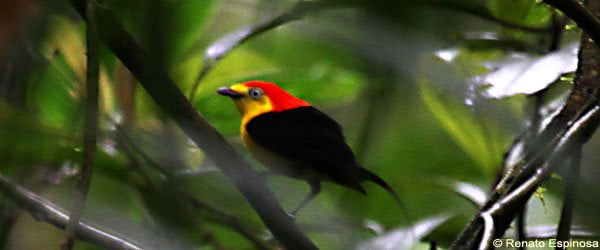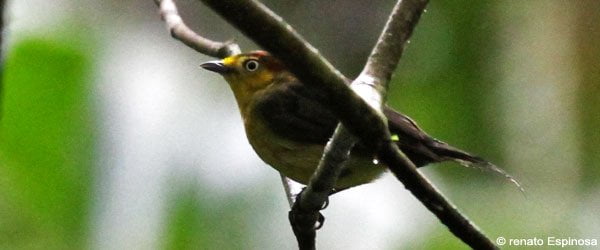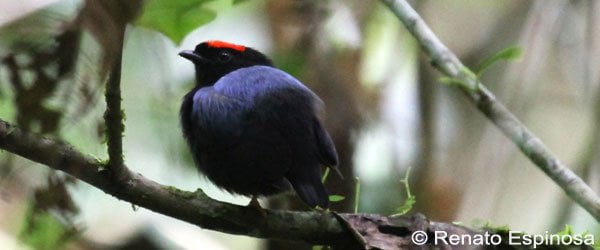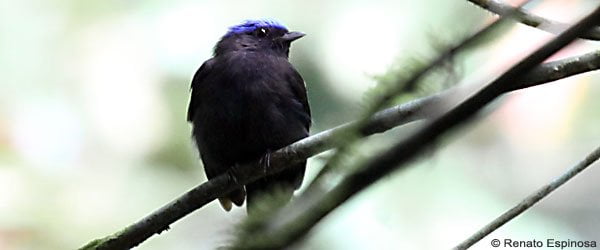Here is Manakin Tour Part One if you missed it.
The next day we headed for a warmer and more humid area of the forest where a new prize awaited us at the end of the trail. This was a tough trail that had not received any maintenance, we had to cross two streams and the small bridges were broken; we waded through some water, pushed away lots of branches, and removed prickly vines from our clothes and skin. As we approached the target area we got some great looks at the Pygmy Owl that Paola spotted in a branch; the sound of the jungle was intense at this early hours and it made it more difficult to find the sought bird by sound. But this task was not difficult for our local guide who quickly and accurately took us some 20 feet in front of the new gem:
Wire-tailed Manakin
I found this video on Youtube that you must watch.
We spent some time admiring this bird and his family as they proceeded to fly back and forth from branch-to-branch as guard dogs running on a fenced in property. We were right at the edge of their lek and they were protecting it and wandering about these stumpy intruders that disturbed their peaceful home. We never saw the female but we did get good looks at a juvenile manakin that was following the guarding rituals that his older parent was presenting to us.
Wire-tailed Manakin Juvenile
Totally satisfied with the experience we left the manakin family in peace and proceeded back to the other forest in search of better views of the Blue-capped Manakin and the Blue-backed Manakin. Unfortunately we never got any better looks so we continued to other habitats in search of other types of birds.
Two days later we drove further into the jungle where an imaginative Ecuadorian signed a lease agreement with the Huaoranies so that he could build a lodge inside their territory and develop a mutual benefiting relationship of conservation and sustainability. I was so impressed with their work that I offered to build a free web site to help them promote their sustainable conservation Project. I will leave their name for the next blog where I will introduce them and their new website. For now we will follow our manakin birds deep in the Huaorani forest where we were pleasantly surprised by the elusive Blue-backed Manakin out in the open. He was so pleased with our presence that he stayed still until I managed to get the best viewing spot to get the picture below:
Blue-backed Manakin
Here is another stunning leking video from YouTube.
In the same way as our previous jewel, the Blue-crowned Manakin also made an unexpected appearance and remained close-by for longer periods so I could get camera focus and a good picture:
Blue-crowned Manakin
I could not find any lekking videos of this manakin but here is another YouTube video that you must see.

















This was great reading. I was inspired by your account. The name Huaorani reminded me of a story about missionaries killed in Ecuador in 1956 (or thereabouts). Did that happen in that area? I was a missionary child in Africa at the time.
Man, do I love manakins. Great shots and report, Renato!
@Dan: Yes you are correct, the Huaoranies killed some missionaries some thirty years ago in the same area where we were birding. Time has changed them in many ways but their wild side comes out when you talk to them today. We talked with a 75 year old Huarani that looked 50 and he talked about killing like if it is something his was proud to do; not only do I mean killing animals but also people. I don´t know if he was involved in the killing of the missionaries but he mentioned it in our visit which gave me chill! And now you give me another chill for mentioning it!
These guys are usually not hired as birding guides (although their keen sense of the jungle would be and enormous asset) because some of them would go back and kill the birds that have established territories. These guys are the real wild thing! Birding the Amazon is an unforgettable experience.
@Mike: I hope you get well soon and gather some momentun to come visit the jungle in Ecuador.